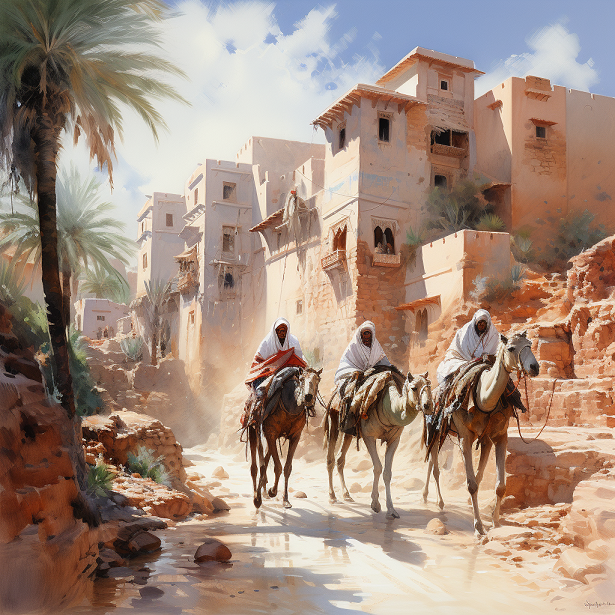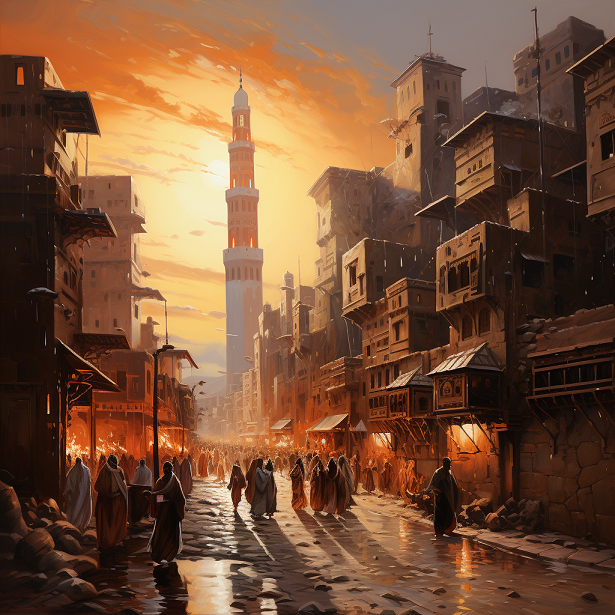Exploration serves as a crucial lens through which we unveil the mysteries of diverse landscapes, and one such enigma lies in the heart of Arabia—Nejd. This central region, obscured by the scarcity of European eyewitness accounts, beckoned the curiosity of Victorian explorers seeking to decode its geographical intricacies and socio-political nuances. In the annals of history, Nejd has maintained an air of mystery, and this article attempts to unravel its secrets through the lens of European explorers, delving into the tales of Doughty, Huber, Palgrave, and Nolde. As we traverse the Mecca track, encounter nomadic Bedawins, and witness the pastoral landscapes supporting tribes like Harb and Ateiba, a vivid panorama of Nejd’s essence unfolds.
European Explorers in Nejd
The exploration of Nejd, a region shrouded in historical obscurity, beckons the curiosity of European trailblazers seeking to penetrate its secrets. Englishman Charles Doughty and Frenchman Charles Huber, drawn by the allure of this terra incognita, ventured forth, their testimonies becoming the threads that weave our understanding of the north of Nejd. Their journeys, which took place within a few years of each other, left behind reasonably detailed accounts that illuminate the landscape’s vastness.
Geography of Mecca Track
The Mecca track, a sinuous route through high plains, offers a unique vantage point to comprehend the topography of Nejd. This arduous path, marked by a gradual ascent for three hundred miles, unfolds before the traveller, revealing a landscape adorned with black pebbles, sparse settlements, and intermittent wells—a composition tailored to Bedouin existence. The largest purely pastoral tract in Arabia, this region cradles the nomadic life of tribes like Harb and Ateiba.
Tribes in Nejd
As the Mecca track unfolds its panorama, it unveils not only the stark beauty of the landscape but also the nomadic tribes that call Nejd home. The Harb and Ateiba, two formidable wandering tribes, find their sanctuary in this expansive pastoral realm. In the limited testimony left by European explorers, these tribes emerge as key players, navigating the vastness with a profound connection to the land.
William Palgrave and Eduard Nolde, in their audacious march from Kasim into the south center of the peninsula, ventured where few had trodden before. While Nolde’s account remains sparse, Palgrave becomes our best informant, offering a first-hand narrative that transcends the meager details provided by predecessors. Nolde, a German adventurer, guided from Bereida to the indefinite frontier of Washm, encountered the war-camp where Muhammad ibn Abdul Wahhab had secured the southern oases’ final submission. In this encounter, the Harb and Ateiba tribes play a pivotal role, their existence intertwined with the historical fabric of Nejd.
William Palgrave, another significant contributor to Arabian exploration, emerges as the harbinger of knowledge, unravelling the mysteries of southern Nejd. His journey, laden with risk and determination, serves as a beacon, shedding light on the territories of Sedeir and Ared, where the pastoral landscape thrives and vibrant communities defy the region’s arid reputation.
Further Southern Exploration
Palgrave and Nolde, propelled by an insatiable thirst for discovery, embarked on an unprecedented journeys beyond the confines of Kasim. While Nolde’s account remains a mere whisper in the historical record, Palgrave’s narrative unfolds as a detailed account, weaving together the threads of exploration in the uncharted south of Nejd.
Palgrave’s sojourn, marked by audacity and an unyielding spirit, led him through the heart of the peninsula, into the provinces of Sudair and Ared. Departing from the Mecca track, he ventured into the southern realms, following a direct path to the wells of Shaiba on Zobeide’s road. The landscape he traversed, reminiscent of the Ateiba plains to the west, unfurled as a vast steppe, adorned with thin grass and sparse tree-clumps. His encounters with settlements were scarce, and the arduous journey necessitated nightly excursions for supplies, an arduous act of survival in the heart of the Arabian expanse.
Palgrave’s journey, a testament to his audacious passage from Qaseem to the shores of the Persian Gulf, stands as a defining moment in the exploration of Nejd. The lands he crossed, where settlements were rare and water sources intermittent, became the backdrop for his encounter with a mysterious Emir in the war-camp near Shakra. From here, his journey continued northward, threading through the narrow corridors between the Rumma, crossing from Rass to Aneiza, leaving behind a trail of firsthand accounts that would form the bedrock of our understanding of southern Nejd.
Description of Sudair and Ared
Palgrave’s narrative, a rich tapestry woven through the provinces of Sudair and Ared, unfolds as a captivating exploration into the heart of southern Nejd. His observations provide a vivid portrait of the distinct characteristics defining these enigmatic territories.
Sudair, a chalky down-land, reveals itself to the intrepid explorer. Its sparse vegetation, thin tree-clumps, and arable land create a landscape where survival depends on the ingenuity of its inhabitants. Palgrave’s keen eye discerns the shallow streams, their waters spent in irrigation or absorbed into calcareous beds. Yet, within this seemingly harsh environment, villages emerge in the labyrinth of steep-sided valleys. Civility, hospitality, and settled order prevail, painting a picture of resilience and resourcefulness in the face of challenging conditions.
The plateau, ascending towards the south, unveils its summit adorned with lush herbage and abundant game—a testament to the adaptability of communities thriving in this seemingly inhospitable terrain. Two settlements, Mejma and Tueim, bear the weight of history, with Palgrave assigning them town rank and estimating their populations as numbering up to 15,000, offering glimpses into the enduring legacy of Nejd’s inhabitants.
As the narrative progresses, Palgrave’s expedition reaches the frontier of Ared at Horeimle, a pivotal moment in the exploration of southern Nejd. The great valley, winding through Sedus and Ayane to the ruins of Deraiye and the existing capital, Riyadh, emerges as the lifeblood of South Nejd—a corridor of rivalries and historical significance.
The Valley of Ared and the Arrival at Riyadh
Palgrave’s journey, akin to an odyssey through the uncharted heart of Nejd, reaches a climactic juncture as the party descends into the valley of Ared. This southward-trending valley, deeper and more continuous than its counterparts, becomes the focal point of the narrative, leading the expedition to the frontier of Ared at Horeimle.
Winding through Sedus and Ayane, the valley extends its reach to the ruins of Deraiye and the contemporary capital, Riyadh. Known as Wady Hanifa in its mid-course, this geographical feature, partially explored, remains an integral part of South Nejd’s topography. Palgrave’s description, as he traverses this fertile corridor, paints a picture of a landscape “a good league in breadth, full of trees and brushwood.” The great gardens of Deraiye, a testament to the historical significance of this region, hint at a bygone era when the town might have housed a substantial population.
As the party progresses, the sprawling expanse of Riyadh unfurls before them—a wide open valley adorned with palm trees, green fields, and well-watered gardens. The towering structures of Feysul’s royal castle and the palace of ‘Abd ‘Allah dominate the skyline, a visual attestation of power and authority. The surrounding plains, extending for miles, reveal a sea of palm-trees, villages like Manfoohah dotting the landscape, and the distant blue hills of the Sierra of Yamamah completing the panoramic vista.
Palgrave’s fifty-day sojourn in Riyadh becomes a pivotal chapter, offering a unique glimpse into the heart of Wahabism, the political dynamics, and the vibrant socio-cultural tapestry that defines this central Arabian city.
Sojourn in Riyadh: A Glimpse into Wahabi Territory
Palgrave’s extended stay in Riyadh, spanning fifty days, provides a rare and intimate insight into the heart of Wahabi territory. As he immerses himself in the cultural, political, and social dynamics of this central Arabian city, the narrative unfolds with a focus on the multifaceted aspects that define Riyadh during this period.
The capital city, with its large and square layout, dominated by the formidable structures of Feysul’s royal castle and ‘Abd ‘Allah’s palace, becomes the stage for Palgrave’s observations. The visual spectacle of a wide-open valley, lush with palm trees and well-tended gardens, contrasts with the austere reputation of the Arabian desert. Riyadh’s expansive plains, stretching for miles, are interwoven with villages like Manfoohah and picturesque groves, offering a testament to the thriving life nurtured within this seemingly arid landscape.
Palgrave, ever the astute observer, delves into the social fabric of Riyadh. Settlements, including Mejma and Tueim, reveal a populace living in the shadow of Faysal, with a healthy, industrious disposition. The roads, free of landlopers, and the overall atmosphere exude a sense of civility and order, challenging the outsider’s preconceived notions about the harshness of desert life.
Yet, beneath the surface lies the undercurrents of Wahabi influence. Palgrave, with a critical eye, dissects the Wahabi society, portraying it as a stern yet childish tyranny, marked by fatalistic tendencies and a kindling of burnt-out fanaticism. His perspective, though tinged with personal biases, lays bare the complexities of a society at the intersection of spirituality and political power.

Palgrave’s Escape from Riyadh
The pinnacle of Palgrave’s Arabian odyssey is marked by a dramatic turn of events—an escape from the clutches of Riyadh, a city entrenched in Wahabi authority. As the narrative unfolds, the tension rises, and Palgrave becomes both the chronicler and protagonist of an escapade that defies the odds.
The political landscape in Riyadh, with its intricate power dynamics, becomes a backdrop to Palgrave’s daring departure. The truculent son of the Emir, the treacherous wazir, and the ever-watchful eyes of Wahabi townsmen contribute to an environment fraught with suspicion and danger. In this context, a certain Abu Aysa, a key figure in the latter part of the adventure, emerges as the architect of an escape plan that would test the limits of courage and resourcefulness.
The narrative, at this juncture, transcends mere geographical exploration, transforming into a gripping tale of survival and evasion. Palgrave, conscious of his responsibility to science and driven by the urgency of the situation, navigates the labyrinthine paths of Riyadh to orchestrate a departure that borders on the miraculous. The escape unfolds against the backdrop of a wide-open valley, where Riyadh sprawls below, crowned by the imposing structures of Feysul’s castle and ‘Abd ‘Allah’s palace.
The ensuing chapters of Palgrave’s journey, leading away from Riyadh, are characterised by a narrative tension that reverberates through the pages. The escape becomes a testament to the audacity of exploration in the face of political adversity and personal peril.
Palgrave’s Homeward Journey
Palgrave’s escape from the heart of Wahabi territory marks the beginning of his homeward journey, a transition from the intricate landscapes of Nejd to the vast expanses beyond Arabian deserts. The subsequent chapters of his narrative weave a tapestry of diverse terrains and cultures as he embarks on the final leg of his remarkable expedition.
Leaving Riyadh behind, the narrative unfolds as the disguised “Syrian” strikes a path reminiscent of Sadlier’s or parallel to it, delving into the low and hot oases of Yemama. This region, divided only by the hotter Harik from the great unknown sands, becomes a crucial waypoint in Palgrave’s trajectory. The desert belt, described with vivid detail, adds another layer to the explorer’s journey—a transition from the agricultural abundance of Nejd to the arid challenges of the broader Arabian landscape.
The narrow barrier sands, a painful but navigable passage for the contingent of troops from Hasa, lead the expedition to Hofuf. The subsequent route takes Palgrave through Bahrain and Oman, bridging the Arabian deserts to distant shores beyond. Each step in this homeward journey is marked by a contrast of landscapes, from the scorching desolation of the desert belt to the coastal regions of Bahrain, each holding its own allure and challenges.
Palgrave’s return, while physically retracing his steps, marks a departure from the heart of Arabia to the broader canvas of the Arabian Peninsula. The narrative, now winding down, encapsulates the essence of an extraordinary exploration—a journey that not only traversed geographical boundaries but also delved into the cultural and political tapestry of a region shrouded in mystery.

